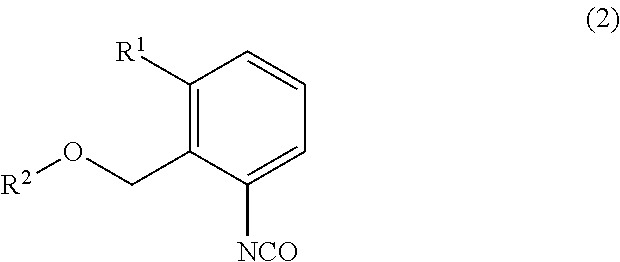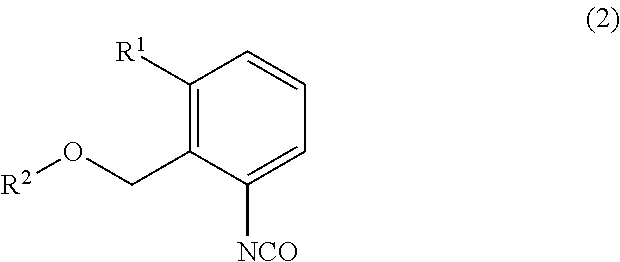Isocyanate compound manufacturing method
a technology of isocyanate and manufacturing method, which is applied in the preparation of isocyanic acid derivatives, organic compound preparation, organic chemistry, etc., can solve the problems of unsatisfactory industrial-scale manufacturing method with respect to yield, and achieve the effect of higher yield
- Summary
- Abstract
- Description
- Claims
- Application Information
AI Technical Summary
Benefits of technology
Problems solved by technology
Method used
Image
Examples
example 1
[0015]Triphosgene (31.4 g) was dissolved in chlorobenzene (200 g) under a nitrogen atmosphere, and then the resultant solution was cooled to 12° C. 3-Methyl-2-methoxymethylaniline (40.0 g) was added to the solution dropwise over 3 hours at the same temperature. After the completion of the dropwise addition, the solution was further stirred for 1.5 hours at the same temperature. A mixture of triethylamine (64.2 g) and chlorobenzene (40 g) was dropwise added to the resultant mixture over 5 hours, and the resultant solution was further stirred for 3 hours to cause the precipitation of crystals. The crystals were filtered, and a filtrate was analyzed by liquid chromatography. As a result, it was found that 3-methyl-2-methoxymethyl-1-isocyanatobenzene (45.7 g) was contained in the filtrate (yield: 97.4%).
example 2
[0016]Triphosgene (31.4 g) was dissolved in chlorobenzene (200 g) under a nitrogen atmosphere, and then the resultant solution was cooled to 10° C. 3-Methyl-2-methoxymethylaniline (40.0 g) was added to the solution dropwise over 3 hours at the same temperature. After the completion of the dropwise addition, the solution was further stirred for 1.5 hours at the same temperature. A mixture of triethylamine (64.2 g) and chlorobenzene (40 g) was added to the resultant mixture dropwise over 5 hours, and the resultant solution was further stirred for 3 hours to cause the precipitation of crystals. The crystals were filtered, and a filtrate was analyzed by liquid chromatography. As a result, it was found that 3-methyl-2-methoxymethyl-1-isocyanatobenzene (44.6 g) was contained in the filtrate (yield: 95.0%).
example 3
[0017]Triphosgene (31.4 g) was dissolved in chlorobenzene (200 g) under a nitrogen atmosphere, and then the resultant solution was cooled to 14° C. 3-Methyl-2-methoxymethylaniline (40.0 g) was added to the solution dropwise over 3 hours at the same temperature. After the completion of the dropwise addition, the solution was further stirred for 1.5 hours at the same temperature. A mixture of triethylamine (64.2 g) and chlorobenzene (40g) was added to the resultant mixture dropwise over 5 hours, and the resultant solution was further stirred for 3 hours to cause the precipitation of crystals. The crystals were filtered, and a filtrate was analyzed by liquid chromatography. As a result, it was found that 3-methyl-2-methoxymethyl-1-isocyanatobenzene (45.0 g) was contained in the filtrate (yield: 95.9%).
Reference Examples
[0018]Triphosgene (31.4 g) was dissolved in chlorobenzene (200 g) under a nitrogen atmosphere, and then 3-methyl-2-methoxymethylaniline (40.0 g) was added to the solutio...
PUM
| Property | Measurement | Unit |
|---|---|---|
| time | aaaaa | aaaaa |
| weight | aaaaa | aaaaa |
| temperature | aaaaa | aaaaa |
Abstract
Description
Claims
Application Information
 Login to View More
Login to View More - R&D
- Intellectual Property
- Life Sciences
- Materials
- Tech Scout
- Unparalleled Data Quality
- Higher Quality Content
- 60% Fewer Hallucinations
Browse by: Latest US Patents, China's latest patents, Technical Efficacy Thesaurus, Application Domain, Technology Topic, Popular Technical Reports.
© 2025 PatSnap. All rights reserved.Legal|Privacy policy|Modern Slavery Act Transparency Statement|Sitemap|About US| Contact US: help@patsnap.com



